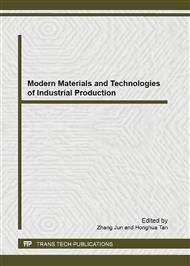[1]
Jia Hong-jie, Yu Yin-xin, Wang Chen-Shan. Chaotic Phenomena in Power Systems and its Studies. Proceedings of the CSEE. 2001, 21(7).
Google Scholar
[2]
Li Qing-du, Yang Xiao-song. A Simple Method for Finding Topological horseshoes. International Journal of Bifurcation and Chaos. 2010, 20(2).
DOI: 10.1142/s0218127410025545
Google Scholar
[3]
E N Lorenz. Deterministic nonperiod, flow. Journal of the Atmospheric Sciences. 1963, 20.
Google Scholar
[4]
Chen G R; Ueta T. International Journal of Bifurcation and Chaos. (1999).
Google Scholar
[5]
Lu Jin-hu, Chen Guan-rong, Cheng Dai-zhan, Sergej Celikovsky. Bridge the gap between the Lorenz system and the Chen system. International journal of bifurcation and chaos in applied sciences and engineering. 2002, 12(12).
DOI: 10.1142/s021812740200631x
Google Scholar
[6]
Liu CX, Liu T, Liu L, Liu K. A new chaotic attractor. Chaos, Solitons and Fractals. 2004, 22(5).
DOI: 10.1016/j.chaos.2004.02.060
Google Scholar
[7]
Qi GY, Chen GR, Du SZ, Chen ZQ, Yuan ZZ. Analysis of a new chaotic system. Physica. A, Statistical & Theoretical Physics. 2005, 352[2-4].
Google Scholar
[8]
Udaltsov V S, Goedgebuer J P, Larger L, Cuenot J B, Rhodes W T. Optics and Spectroscopy. (2003).
Google Scholar
[9]
Jin-Yuan Hsieh, Chi-Chuan Hwang, An-Pei Wang, Woei-Jong LiM. Controlling hyperchaos of the Rossler systems. International Journal of Control. 1999, 72(10).
Google Scholar
[10]
Song YZ. Chinese Physics. (2007).
Google Scholar
[11]
Liang Song, Zhu Hong-Liang, Pan Jiao-Qing, Wang Wei. Dependence of bimodal size distribution on temperature and optical properties of InAs quantum dots grown on vicinal GaAs (100) substrates by using MOCVD. Chinese physics. 2006, 15(5).
DOI: 10.1088/1009-1963/15/5/042
Google Scholar
[12]
Wiggins S. Introduction to Applicd Nonlinear Dynamical Systems and Chaos. New York: springer-verlag. (1990).
Google Scholar
[13]
Morse M, G A Hedlund. Symbolic dynamics. American Journal of Mathematics. 1938, 60(4).
Google Scholar
[14]
Kennedy J, Yorke J A. Topological horseshoes. Transac-tions of the American Mathematical Society. 2001, 353(6).
Google Scholar
[15]
Yang X S, Tang Y. Horseshoes in piecewise continuous maps. Chaos, Solitons&Fractals. 2004, 19(4).
DOI: 10.1016/s0960-0779(03)00202-9
Google Scholar
[16]
Wu Wenjun, Meng Fanshun, Li Jing. Co-sensitization with near-IR absorbing cyanine dye to improve photoelectric conversion of dye-sensitized solar cells. Synthetic Metals. 2009, 159(11).
DOI: 10.1016/j.synthmet.2009.01.023
Google Scholar
[17]
Li Qing-du, Yang Xiao-song. Progresses on Chaotic Dynamics Study with Topological horseshoes. Journal of Dynamics and Control. 2012, 10(4).
Google Scholar


